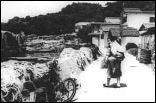|
|
 |
製作:フィルム工房 Production Company : Film Kobo |
| 水俣の1982年。カラーではじまるこの作品は不知火海を有機水銀で汚染したあのチッソ水俣工場とその経緯を簡単に説明し、海中の汚染状況を再検した後、小さな横浦島のある一家にカメラを向ける。フィルムは白黒に入れ替わり、誰しもがあの「水俣」シリーズを撮り続けた土本典昭の作品と比較するであろう不知火海の映像が現れる。78年になって漸く患者申請した岩本さん一家。何度も自殺を考えたという湯堂に住む吉本モモエさん、そして女島の網元の息子緒方さんと、その姉で、胎児性水俣病の達純くんを育てた小崎さん一家。達純くんはかつて土本の水俣第1作『水俣-患者さんとその世界』にも出演していたあの子供の成長後の姿。彼は病状がますます悪化していることを我々に告白する。若いスタッフたちは土本の作品以降を、患者たちの日常の中に再発見しようという強い意志があった訳ではない。しかし成長した子供たちの顔によって、そして不知火の海で漁をする小舟の遠景によって、我々は再びあの『水俣−患者さんとその世界』(監督・土本典昭)の入り口に立たされることになる。スタッフの中には後に『阿賀に生きる』を撮る佐藤真が加わっている。 | Minamata, 1982. The film begins in color, with a simple explanation of the pollution of the Shiranui Sea by organic mercury from Chisso Corporation's Minamata factory. After a reexamination of the present water pollution situation, the cameras turn to a single family on tiny Yokoura Island. The film then switches to black and white, and the images of the Shiranui Sea which appear will undoubtedly remind many of Tsuchimoto Noriaki's Minamata series. In 1978 the Iwamoto family finally applied for recognition as victims of Minamata disease. The family members include: Yoshimoto Momoe who lives in Yudo and who has considered suicide many times; Ogata, the son of the leader of the fishing village Mejima; and Kozaki, the leader's daughter who raises her son Tatsuzumi, who was himself affected by mercury poisoning whilst still in the womb. Tatsuzumi has grown up since he appeared in Tsuchimoto's first film in the series, Minamata: The Victims and Their World, ( " Minamata: kanjasan to sono sekai, " 1971). He confesses to us that his condition continues to get worse. After the other Tsuchimoto films, the young film crew of The Innocent Sea was rather reticent to delve once more into the daily lives of those suffering from the disease. However, the faces of children grown to young adulthood against the back ground of small boats fishing in the Shiranui Sea returns one forcefully to the threshold of the Tsuchimoto film. One member of the film crew, Sato Makoto went on to work on Living on the River Agano ( " Aga ni ikiru, " 1992), a film about the effects of industrial development on the people living by the Agano River in Niigata. |